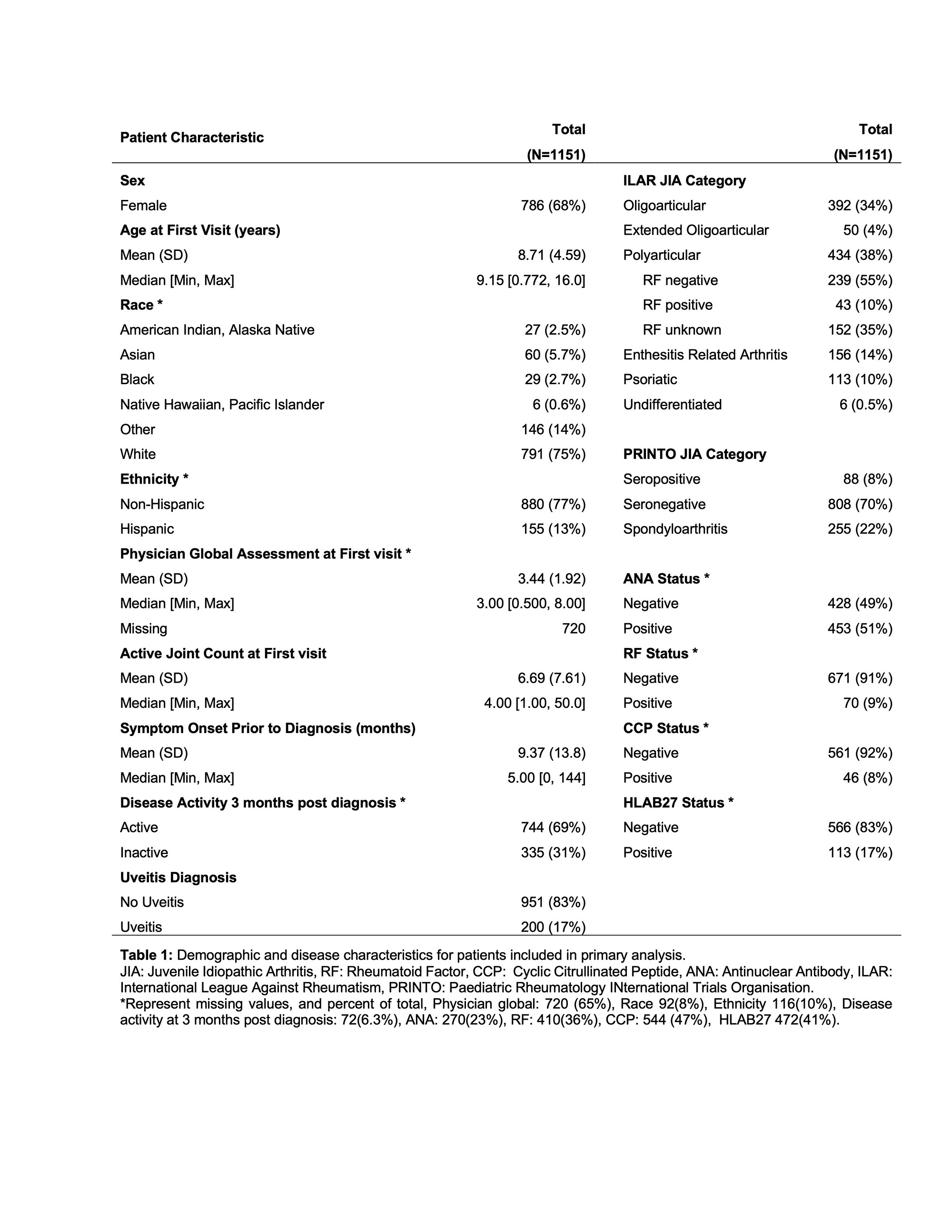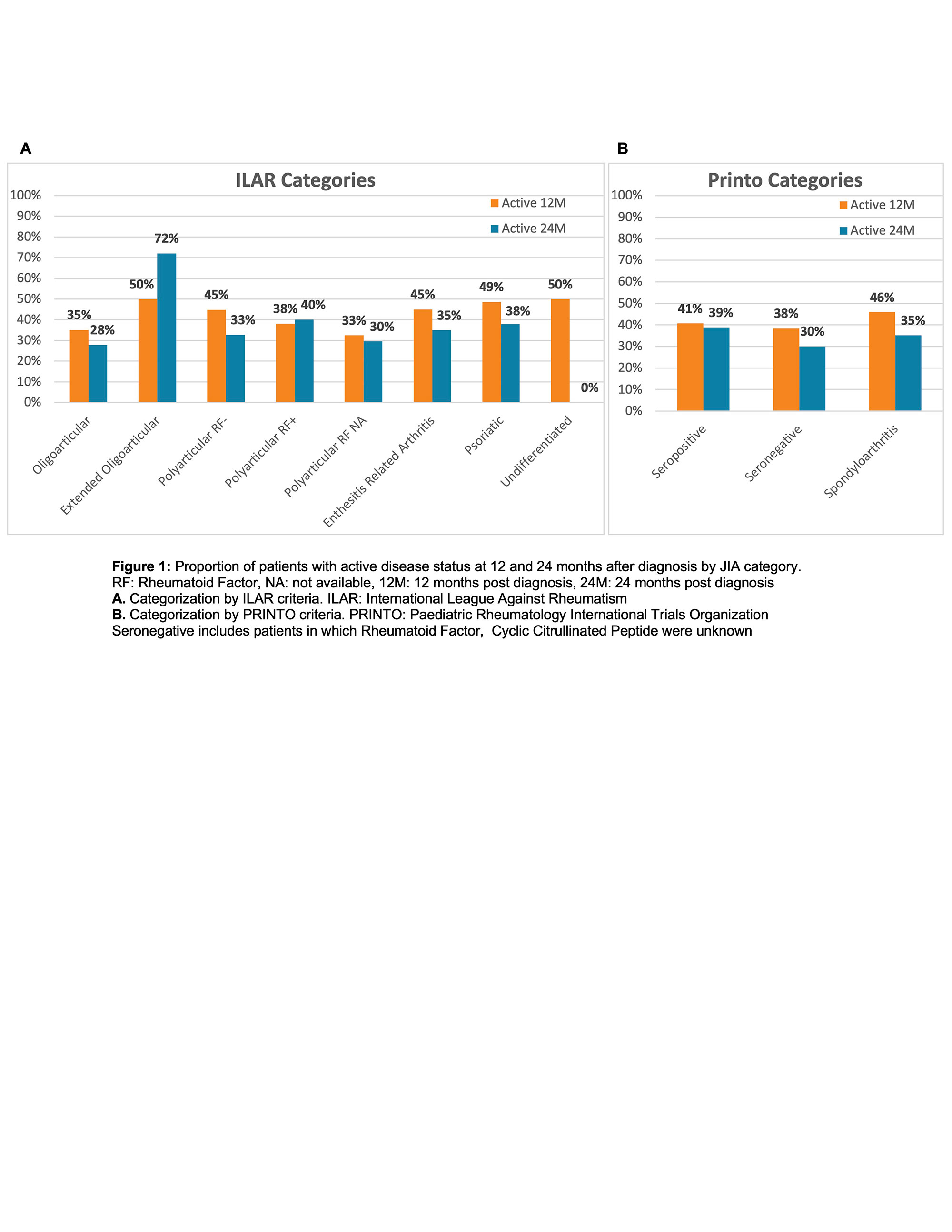Session Information
Session Type: Poster Session B
Session Time: 9:00AM-10:30AM
Background/Purpose: Juvenile Idiopathic Arthritis (JIA) is the most common rheumatologic disease in children. JIA disease course and prognosis varies significantly between its seven categories, and patients face the possibility of debilitating arthritis and deformity. Identification of patients at risk for severe and prolonged active disease is likely to affect treatment strategies, especially in the early disease state within the postulated window of opportunity. Two large foreign cohorts, including the Canadian ReACCh-Out and the Nordic cohorts have created predictive disease course models. However, to date there are limited United States data describing predictive factors for persistently active JIA early in the disease course beyond those presented in the STOP JIA trial which suggested early detection of adverse disease trajectories in polyarticular disease is possible. This study seeks to evaluate patients by both traditional ILAR and proposed PRINTO category for characteristics which may predict early JIA disease course.
Methods: We conducted a single center retrospective cohort study with 1151 JIA patients diagnosed from 2004 – 2018, excluding those with systemic onset JIA, to identify possible patient characteristics associated with active disease at 12 and 24 months post diagnosis. Patient predictor variables included: age, sex, race, ethnicity, duration of symptoms prior to diagnosis, inflamed joint count at diagnosis, serologies, uveitis status, primary language, insurance status, distance to treating rheumatologist, and early response to therapy at 3 months, as well as ILAR and PRINTO JIA category. Primary outcomes include active and inactive disease at 12 and 24 months. Inactive disease was defined by physician global assessment of 0/10 and modified Wallace criteria. Through univariate logistic regression analysis we will evaluate for predictive variables of active disease status in the first 24 months after diagnosis. A secondary multivariate logistic regression analysis will be completed based on significant univariate findings.
Results: Descriptive analysis of patient characteristics are shown in Table 1. Our population was 68% female, with 38% classified as polyarticular and 34% as oligoarticular, primarily White (75%) and non-Hispanic (77%). In the total JIA cohort, 40% (449) of patients had active disease at 12 months and 33% (328) had active disease at 24 months after diagnosis. Disease activity by JIA category demonstrates differences are present between categories when patients are categorized by both ILAR and PRINTO standards (Figure 1). Predictor analysis for outcomes is ongoing at this time.
Conclusion: Disease activity status at 12 months by ILAR category was overall similar to the Canadian cohort, and slightly lower for polyarticular patients than the STOP JIA cohort. This study is the first of its kind to evaluate patients for disease activity outcomes based on proposed PRINTO categories in comparison to ILAR categories. In our planned analysis we hypothesize that when evaluating patients by JIA category, there will be characteristic predictors, beyond JIA category, associated with higher prevalence of active disease at 12 and 24 months post diagnosis.
To cite this abstract in AMA style:
Balay E, Shenoi S. Investigation of Predictive Factors for Active Disease Status Within 24 Months of Juvenile Idiopathic Arthritis Diagnosis [abstract]. Arthritis Rheumatol. 2022; 74 (suppl 9). https://acrabstracts.org/abstract/investigation-of-predictive-factors-for-active-disease-status-within-24-months-of-juvenile-idiopathic-arthritis-diagnosis/. Accessed .« Back to ACR Convergence 2022
ACR Meeting Abstracts - https://acrabstracts.org/abstract/investigation-of-predictive-factors-for-active-disease-status-within-24-months-of-juvenile-idiopathic-arthritis-diagnosis/


